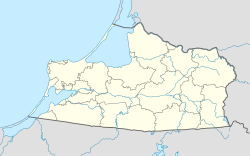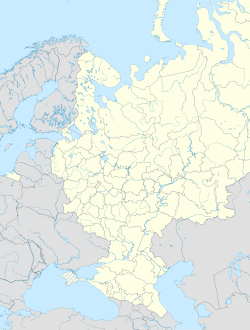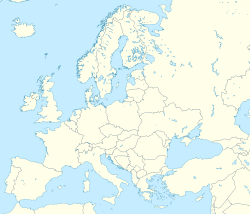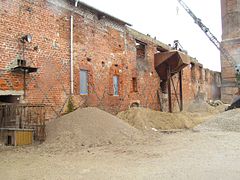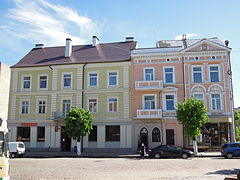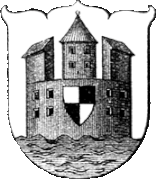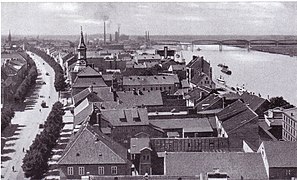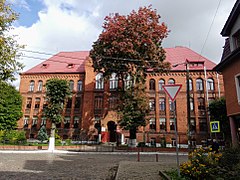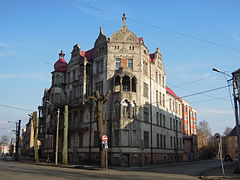Sovetsk, Kaliningrad Oblast
Sovetsk
Советск | |
|---|---|
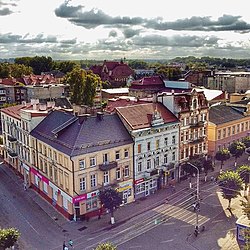 Old town of Sovetsk, with German-era buildings | |
| Coordinates: 55°04′51″N 21°53′11″E / 55.08083°N 21.88639°E | |
| Country | Russia |
| Federal subject | Kaliningrad Oblast |
| Founded | 1288 |
| Town status since | 1552 |
| Government | |
| • Head | Viktor Smilgin |
| Elevation | 10 m (30 ft) |
| Population | |
• Total | 41,705 |
| • Subordinated to | town of oblast significance of Sovetsk[2] |
| • Capital of | town of oblast significance of Sovetsk[2] |
| • Urban okrug | Sovetsky Urban Okrug[3] |
| • Capital of | Sovetsky Urban Okrug[3] |
| Time zone | UTC+2 (MSK–1 |
| Postal code(s)[5] | 238750 |
| Dialing code(s) | +7 40161 |
| OKTMO ID | 27730000001 |
| Website | sovetsk |
Sovetsk (Russian: Сове́тск; German: Tilsit [ˈtɪlzɪt] ⓘ;[8] Old Prussian: Tilzi; Lithuanian: Tilžė) is a town in Kaliningrad Oblast, Russia, located on the south bank of the Neman River which forms the border with Lithuania.
History
[edit]Early history
[edit]Tilsit, which received civic rights from Albert, Duke of Prussia in 1552,[9] developed around a castle of the Teutonic Knights, known as the Schalauer Haus, founded in 1288. In 1454, King Casimir IV Jagiellon incorporated the region to the Kingdom of Poland upon the request of the anti-Teutonic Prussian Confederation.[10] After the subsequent Thirteen Years' War (1454–1466), the settlement was a part of Poland as a fief held by the Teutonic Knights,[11] and thus was located within the Polish–Lithuanian union, later elevated to the Polish–Lithuanian Commonwealth.
In the winter of 1678–1679, during the Scanian War, the town was occupied by Sweden.[9] From the 18th century, it was part of the Kingdom of Prussia. During the Seven Years' War, in 1757–1762, the town was under Russian control.[9] Afterwards it fell back to Prussia.
Late modern period
[edit]
The Treaties of Tilsit were signed here in July 1807, the preliminaries of which were settled by the emperors Alexander I of Russia and Napoleon I of France on a raft moored in the Neman River. This treaty, which created the Kingdom of Westphalia and the Duchy of Warsaw, completed Napoleon's humiliation of the Kingdom of Prussia, when it was deprived of one half of its dominions. Three days before its signing, the Prussian queen Louise (1776–1810) tried to persuade Napoleon in a private conversation to ease his hard conditions on Prussia; though unsuccessful, Louise's effort endeared her to the Prussian people.
In 1811, a new ship-of-the-line of the French navy was named Tilsitt, to commemorate this treaty. This ship of 80 guns of the Bucentaure class was built in Antwerp. After the fall of the French empire, the ship was transferred to the new Dutch navy and named Neptunus.
Until 1945, a marble tablet marked the house in which King Frederick William III of Prussia and Queen Louise resided. Also, in the former Schenkendorf Platz was a monument to the poet Max von Schenkendorf (1783–1817), a native of Tilsit; a statue of Lenin was erected in its place in 1967.
Following the unsuccessful Polish November Uprising, hundreds of Polish insurgents, including professors and students of the Wilno University, were interned in the town in 1832.[12]
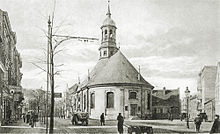
During the 19th century when the Lithuanian language in Latin characters was banned within the Russian Empire, Tilsit was an important centre for printing Lithuanian books which then were smuggled by Knygnešiai to the Russian-controlled part of Lithuania. The Lithuanian Literary Society with a library and an archaeological collection was active in the town.[13] In the 19th century, there were four churches in the town: two Lutheran (one Lithuanian and one German), one Calvinist, and one Catholic, as well as a synagogue.[13] In general, Tilsit thrived and was an important Prussian town. The Geographical Dictionary of the Kingdom of Poland from 1892 referred to the town as the capital of Lithuania Minor.[14] The local Lithuanian population was subjected to Germanisation policies, intensified after the city became part of the German Empire in 1871, which resulted in a decrease in the share of Lithuanians in the town's population. In 1877, weekly German-language services were introduced in the Lithuanian church, alongside the Lithuanian services.[13] In 1884, Lithuanians formed 13% of the town's population.[14] By 1900 it had electric tramways and 34,500 inhabitants; a direct railway line linked it to Königsberg (Kaliningrad) and Labiau (Polessk) and steamers docked there daily. According to the Prussian census of 1905, the city of Tilsit had a population of 37,148, of which 96% were Germans and 4% were Lithuanians.[15] The bridge was built in 1907 and rebuilt in 1946. The town was occupied by Russian troops between 26 August 1914 and 12 September 1914 during World War I. The Act of Tilsit was signed here by leaders of the Lietuvininks in 1918.

World War II and post-war period
[edit]Hitler visited the town just before World War II, and a photo was taken of him on the famous bridge over the Neman River. During the war, the Germans operated a forced labour subcamp of the Stalag I-A prisoner-of-war camp for Allied POWs in the town,[16] and expelled Poles from German-occupied Poland were also enslaved as forced labour in the town's vicinity.[17] Tilsit was occupied by the Red Army on January 20, 1945 (during the East Prussian offensive), and was annexed by the Soviet Union in 1945. The remaining Germans who had not evacuated were subsequently expelled in accordance with the Potsdam Agreement and replaced with Soviet citizens. The town was renamed Sovetsk in honor of Soviet rule.
Modern Sovetsk has sought to take advantage of Tilsit's tradition of cheese production (Tilsit cheese), but the new name ("Sovetsky cheese") has not inherited its predecessor's reputation.
Since the dissolution of the Soviet Union in 1991, there has been some discussion about the possibility of restoring the town's original name.[18] In 2010, the Kaliningrad Oblast's then-governor Georgy Boos of the ruling United Russia Party proposed restoring the original name and combining the town with the Neman and Slavsk Districts to form a new Tilsit District. Boos emphasized that this move would stimulate development and economic growth, but that it could happen only through a referendum.[19] The idea was opposed by the Communist Party of Russia; in particular, Igor Revin, the Kaliningrad Secretary of the Communist Party, accused Boos and United Russia of Germanophilia.[20]
In April 2007, government restrictions on visits to border areas were tightened, and for foreigners, and Russians living outside the border zone, travel to the Sovetsk and Bagrationovsk areas required advance permission from the Border Guard Service (in some cases up to 30 days beforehand). It was alleged that this procedure slowed the development of these potentially thriving border towns.[21] In June 2012, these restrictions were lifted (the only restricted area is the Neman river shoreline), which gave a boost to local and international tourism.
Geography
[edit]Sovetsk lies in the historic region of Lithuania Minor[14] at the confluence of the Tylzha and Neman rivers. Panemunė in Lithuania was formerly a suburb of the town; after Germany's defeat in World War I, the trans-Neman suburb was detached from Tilsit (with the rest of the Klaipėda Region) in 1920.
Climate
[edit]Sovetsk has a borderline oceanic climate (Cfb in the Köppen climate classification) using the −3 °C or 26.6 °F boundary, or a humid continental climate (Dfb) using the 0 °C or 32 °F boundary.
| Climate data for Sovetsk | |||||||||||||
|---|---|---|---|---|---|---|---|---|---|---|---|---|---|
| Month | Jan | Feb | Mar | Apr | May | Jun | Jul | Aug | Sep | Oct | Nov | Dec | Year |
| Mean daily maximum °C (°F) | −0.6 (30.9) |
0.7 (33.3) |
5.4 (41.7) |
12.3 (54.1) |
17.5 (63.5) |
20.2 (68.4) |
22.8 (73.0) |
22 (72) |
17.5 (63.5) |
11.1 (52.0) |
6 (43) |
2.1 (35.8) |
11.4 (52.6) |
| Daily mean °C (°F) | −2.7 (27.1) |
−1.8 (28.8) |
1.8 (35.2) |
7.8 (46.0) |
13.1 (55.6) |
16.4 (61.5) |
19 (66) |
18.3 (64.9) |
14 (57) |
8.4 (47.1) |
4.2 (39.6) |
0.4 (32.7) |
8.2 (46.8) |
| Mean daily minimum °C (°F) | −5 (23) |
−4.5 (23.9) |
−1.8 (28.8) |
2.9 (37.2) |
8 (46) |
11.8 (53.2) |
14.8 (58.6) |
14.4 (57.9) |
10.5 (50.9) |
5.8 (42.4) |
2.3 (36.1) |
−1.4 (29.5) |
4.8 (40.6) |
| Average precipitation mm (inches) | 59 (2.3) |
50 (2.0) |
51 (2.0) |
46 (1.8) |
56 (2.2) |
75 (3.0) |
95 (3.7) |
83 (3.3) |
65 (2.6) |
68 (2.7) |
60 (2.4) |
57 (2.2) |
765 (30.2) |
| Source: https://en.climate-data.org/asia/russian-federation/kaliningrad/sovetsk-12841 | |||||||||||||
Administrative and municipal status
[edit]Within the framework of administrative divisions, it is incorporated as the town of oblast significance of Sovetsk—an administrative unit with the status equal to that of the districts.[2] As a municipal division, the town of oblast significance of Sovetsk is incorporated as Sovetsky Urban Okrug.[3]
Architecture
[edit]Many of the town's buildings were destroyed during World War II. However, the old town centre still includes several German buildings, including those of Jugendstil design. The Queen Louise Bridge, now connecting the town to Panemunė in Lithuania, retains an arch – all that is left of a more complex pre-war bridge structure built in 1907. The carved relief portrait of Queen Louise above the arch still exists; however, the German inscription "KÖNIGIN LUISE-BRÜCKE" was removed after the Soviets took over the town.
-
Queen Louise bridge
-
Tilsit castle
-
Old townhouses
-
Old townhouses
-
New Loge, built 1925-26 by Erich Mendelsohn
Historical population
[edit]
Ethnic composition in 2010:[citation needed]
- Russians: 86.7%
- Ukrainians: 3.5%
- Lithuanians: 3.3%
- Belarusians: 2.7%
Twin towns – sister cities
[edit] Kiel, Germany
Kiel, Germany Považská Bystrica, Slovakia
Považská Bystrica, Slovakia
Notable people
[edit]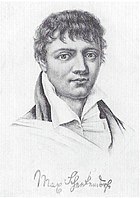
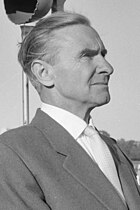
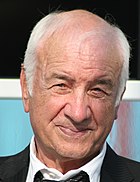

- Daniel Klein (1609–1666), Lithuanian pastor and grammarian
- Johann Christian Jacobi (1719–1784), German oboist
- Max von Schenkendorf (1783–1817), German poet and author
- Franz Meyen (1804–1840), German botanist
- Hans Victor von Unruh (1806–1886), German politician and technician
- Louis Kolitz (1845-1912), German artist
- Wilhelm Voigt (1849–1922), the inspiration for The Captain of Köpenick
- Margarete Poehlmann (1856–1923), German educator and politician, first woman to speak in a Prussian parliament
- Gustaf Kossinna or Kossina (1858–1931), archaeologist
- Johanna Wolff (1858–1943), German author
- Oscar Friedheim (1858–1928), British businessman of German-Jewish descent
- Max Scherwinsky (1859–1909) German-born architect working mainly in Riga, Latvia
- Emil Wiechert (1861–1928), German geophysicist
- Raphael Friedeberg (1863–1940), German physician and politician
- Max Gülstorff (1882–1947), German actor
- Carl Brinkmann (1885–1954), German sociologist and economist
- Franz Scheidies (1890–1942) general in the Wehrmacht during WWII
- Walter Weiß (1890–1967), German general during WWII.
- Friedrich Schröder Sonnenstern (1892–1982), Illustrator
- Dick Shikat (1897–1968) German professional wrestler and World Heavyweight Champion
- Frank Wisbar (1899–1967) German director
- Karl Hermann Martell (1906–1966), German actor
- Franz Abromeit (1907–1964), SS officer, Reichssicherheitshauptamt (Judenreferent)
- Joachim Sadrozinski (1907–1944), officer and resistance fighter
- Erna Dorn (1911–1953) victim of injustice in the German Democratic Republic
- Siegfried Graetschus (1916–1943), SS-Oberscharführer, killed during revolt in Sobibor extermination camp
- Johannes Bobrowski (1917–1965), German writer
- Werner Abrolat (1924–1997), German actor
- Gunter Wyszecki (1925–1985), German-Canadian physicist
- Armin Mueller-Stahl (born 1930), German actor, honorary citizen since 8 December 2011[23]
- Sabine Bethmann (1931–2021), German actress
- Jürgen Kurbjuhn (1940–2014), football player
- Klaus-Dieter Sieloff (1942–2011), football player
- John Kay (born 1944), lead singer of the late 1960s rock band Steppenwolf
- Edgar Froese (1944–2015), German founder and leader of the electronic music group Tangerine Dream
- Victor Ivrii (born 1949) a Soviet, Canadian mathematician
- Andrei Sosnitskiy (born 1962) a Belarusian professional football coach and a former player
Popular culture
[edit]The town is the location of a scene in Leo Tolstoy's War and Peace (Book Two Part Two Chapter 21).[24] Tilsit is the setting for part of the 1939 film "The Journey to Tilsit", which is based on a 1917 novella of the same name written by Hermann Sudermann.
Gallery
[edit]-
Coat of arms of Tilsit (1905)
-
Market square of Tilsit with the town hall and the Schenkendorf statue, 1930
-
Old view of Tilsit, circa 1910
-
Gymnasium
-
The birthplace of Armin Mueller-Stahl, which has been a listed building since 2010
References
[edit]Notes
[edit]- ^ a b Russian Federal State Statistics Service (2011). Всероссийская перепись населения 2010 года. Том 1 [2010 All-Russian Population Census, vol. 1]. Всероссийская перепись населения 2010 года [2010 All-Russia Population Census] (in Russian). Federal State Statistics Service.
- ^ a b c Resolution #639
- ^ a b c Law #376
- ^ "Об исчислении времени". Официальный интернет-портал правовой информации (in Russian). June 3, 2011. Retrieved January 19, 2019.
- ^ Почта России. Информационно-вычислительный центр ОАСУ РПО. (Russian Post). Поиск объектов почтовой связи (Postal Objects Search) (in Russian)
- ^ a b Всесоюзная перепись населения 1989 г. Численность наличного населения союзных и автономных республик, автономных областей и округов, краёв, областей, районов, городских поселений и сёл-райцентров [All Union Population Census of 1989: Present Population of Union and Autonomous Republics, Autonomous Oblasts and Okrugs, Krais, Oblasts, Districts, Urban Settlements, and Villages Serving as District Administrative Centers]. Всесоюзная перепись населения 1989 года [All-Union Population Census of 1989] (in Russian). Институт демографии Национального исследовательского университета: Высшая школа экономики [Institute of Demography at the National Research University: Higher School of Economics]. 1989 – via Demoscope Weekly.
- ^ a b Federal State Statistics Service (May 21, 2004). Численность населения России, субъектов Российской Федерации в составе федеральных округов, районов, городских поселений, сельских населённых пунктов – районных центров и сельских населённых пунктов с населением 3 тысячи и более человек [Population of Russia, Its Federal Districts, Federal Subjects, Districts, Urban Localities, Rural Localities—Administrative Centers, and Rural Localities with Population of Over 3,000] (XLS). Всероссийская перепись населения 2002 года [All-Russia Population Census of 2002] (in Russian).
- ^ M. Kaemmerer (2004). Ortsnamenverzeichnis der Ortschaften jenseits von Oder u. Neiße (in German). G. Rautenberg. ISBN 3-7921-0368-0.
- ^ a b c Słownik geograficzny Królestwa Polskiego i innych krajów słowiańskich, Tom XII, p. 703
- ^ Górski, Karol (1949). Związek Pruski i poddanie się Prus Polsce: zbiór tekstów źródłowych (in Polish). Poznań: Instytut Zachodni. p. 54.
- ^ Górski, pp. 96–97, 214–215
- ^ Kasparek, Norbert (2014). "Żołnierze polscy w Prusach po upadku powstania listopadowego. Powroty do kraju i wyjazdy na emigrację". In Katafiasz, Tomasz (ed.). Na tułaczym szlaku... Powstańcy Listopadowi na Pomorzu (in Polish). Koszalin: Muzeum w Koszalinie, Archiwum Państwowe w Koszalinie. pp. 174, 176.
- ^ a b c Maroszek, Józef (2007). Przewodnik historyczno-turystyczny po dziedzictwie kulturowym pogranicza Polska – Litwa – Kaliningrad (in Polish). Białystok. p. 393.
{{cite book}}: CS1 maint: location missing publisher (link) - ^ a b c d e f Słownik geograficzny Królestwa Polskiego i innych krajów słowiańskich, Tom XII (in Polish). Warszawa. 1892. p. 702.
{{cite book}}: CS1 maint: location missing publisher (link) - ^ Belzyt, Leszek (1998). Sprachliche Minderheiten im preussischen Staat: 1815 - 1914 ; die preußische Sprachenstatistik in Bearbeitung und Kommentar. Marburg: Herder-Inst. ISBN 978-3-87969-267-5.
- ^ Megargee, Geoffrey P.; Overmans, Rüdiger; Vogt, Wolfgang (2022). The United States Holocaust Memorial Museum Encyclopedia of Camps and Ghettos 1933–1945. Volume IV. Indiana University Press, United States Holocaust Memorial Museum. p. 389. ISBN 978-0-253-06089-1.
- ^ Wardzyńska, Maria (2017). Wysiedlenia ludności polskiej z okupowanych ziem polskich włączonych do III Rzeszy w latach 1939-1945 (in Polish). Warszawa: IPN. pp. 395, 405, 410, 416, 423. ISBN 978-83-8098-174-4.
- ^ Karabeshkin, Leonid; Wellmann, Christian (2004). The Russian Domestic Debate on Kaliningrad: Integrity, Identity and Economy. Münster: LIT Verlag. p. 35. ISBN 9783825879525.
- ^ На карте Калининградской области появится Тильзитский район?. Komsomolskaya Pravda (in Russian). March 24, 2010. Retrieved October 6, 2017.
- ^ Stolyarov, Bulat (March 25, 2010). Переименовать город дорого, нужно четко понимать зачем. Snob.ru (in Russian). Retrieved October 6, 2017.
- ^ PONARS Eurasia Memo #16. "EU–Russian Border Security. Stereotypes and Realities." (PDF). (55 Kb])
- ^ "Наши партнеры". sovetsk.gov39.ru (in Russian). Sovetsk. Retrieved February 6, 2020.
- ^ Armin Mueller-Stahl Ehrenbürger seiner Heimatstadt Archived September 23, 2015, at the Wayback Machine Berliner Zeitung, 8 December 2011 (in German)
- ^ Tolstoy, Leo (1949). War and Peace. Garden City: International Collectors Library. pp. 204, 235.
Sources
[edit]- Правительство Калининградской области. Постановление №640 от 30 августа 2011 г. «Об утверждении реестра объектов административно-территориального деления Калининградской области», в ред. Постановления №877 от 21 ноября 2011 г «О внесении изменения в Постановление Правительства Калининградской области от 30 августа 2011 г. №640». Вступил в силу со дня официального опубликования. Опубликован: "Калининградская правда" (вкладыш "Официально"), №170, 15 сентября 2011 г. (Government of Kaliningrad Oblast. Resolution #640 of August 30, 2011 On the Adoption of the Registry of the Objects of the Administrative-Territorial Divisions of Kaliningrad Oblast, as amended by the Resolution #877 of November 21, 2011 On Amending the Resolution of the Government of Kaliningrad Oblast #640 of August 30, 2011. Effective as of the day of the official publication.).
- Калининградская областная Дума. Закон №376 от 31 марта 2004 г. «О наделении муниципального образования "Город Советск" статусом городского округа», в ред. Закона №370 от 1 июля 2009 г «О составе территорий муниципальных образований Калининградской области». Вступил в силу с момента официального опубликования. Опубликован: "Российская газета" ("Запад России"), №88, 27 апреля 2004 г. (Kaliningrad Oblast Duma. Law #376 of March 31, 2004 On Granting the Urban Okrug Status to the Municipal Formation of the "Town of Sovetsk", as amended by the Law #370 of July 1, 2009 On the Composition of the Territories of the Municipal Formations of Kaliningrad Oblast. Effective as of the moment of the official publication.).
- Northern Germany by Karl Baedeker, 14th revised edition, London, 1904, p. 178.
- This article incorporates text from a publication now in the public domain: Chisholm, Hugh, ed. (1911). "Tilsit". Encyclopædia Britannica (11th ed.). Cambridge University Press.




